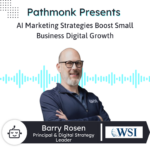CRM SaaS
Introduction
Dustin Tysick, Jostle VP of Marketing & Growth, leads the marketing team at Jostle and we speak about how to identify your internal champion in your target company. Dustin is an entrepreneurial marketer who is equally comfortable designing innovative brand building campaigns or crunching numbers to make sound business recommendations.
He has a passion for using data to improve ROI and ROAS. Dustin shares how his team is identify the “buying champions” for their enterprise deals – those people are key for their success and help selling the product within the enterprise.
See an abstract of the interview on how to identify your internal champion in your target company…
Pathmonk: What is the typical user journey of the deck alike if there is such a thing as a typical user journey?
Dustin Tysick: A lot of our customers do come in either through paid search, organic search. Those are still the two core main drivers. One growing channel for us has actually been converting our blog visitors and blog users into legitimate leads. Customers, that’s always tough, right? Like it’s top of the funnel. How do you then bring them down? How do you filter them down with realizing not everyone’s going to be a customer and that’s okay. So that’s kind of where we’re at. We’re casting this really wide net and up until this point we’ve been almost entirely inbound. Now we’re going to explore outbound a bit more, using some ABM campaigns and that thing.
Pathmonk: How would you think about personas then?
Dustin Tysick: I think this is, I think you’re in a very interesting spot where you mentioned the market tier, a CEO, even somebody from HR, like how do you try to steer the marketing team then on based on which types of persona as a whole to even think about that. Maybe you can give a glimpse into that. We’ve been in business and selling for about 10 years. Over that time we finally got an understanding of our buyers. It takes that time because it’s so diverse. In general, we know based on the size of the company who the most likely buyer is. That being said, it’s never a sole person buying. For example, I could go buy a new marketing automation software and implement it and maybe I bring in one or two people. We’re always selling to a committee. We will always kind of target and try to bring in people from HR, marketing communications and some type of senior leadership. Depending on the size of the company potentially, there’s also an internal communications department that we’ll bring in as well. Who we target and go after is really based on the company and how built out those functions are. Persona wise, ultimately what we’re looking for and digging for and it’s hard to find is the engagement champion. The person who cares the most about company culture, productivity, engagement, if we find that person we can sell really well, it’s just we have to find who that is. Very very interesting challenge. Very cool.
Pathmonk: You mentioned a lot of inbound leads are coming in. What would be the role of the website? Could you describe the role of the website and the overall set up?
Dustin Tysick: In general we want to funnel people and filter them to our main site, either from the blog, from social, from organic search, anywhere we can find them. What we are kind of mantra there is we want to enlighten the visitors. We want to educate them, and also kind of open their eyes as to your old internet doesn’t have to be this way. There’s other things out there. We take a different approach. Once like in the sales cycle when we can make that click and make them realize like, Oh, you guys don’t have pages. Oh you filter things differently. That light bulb kind of goes off. It’s easier in a sales on a website. That’s tough. That’s kind of been our ongoing challenge and we’re continuing to kind of build out the website to help with that journey.
Ptahmonk: We are speaking about the website here but what’s the metrics that you care about from your perspective in your role on the website?
Dustin Tysick: Yeah, so on the paid search side, like the pure landing page form fill site, it really is conversions like you said, which I think is pretty common. The other thing we do look at and I think is important is the number of pages they actually visit in a journey and what those pages are. We bucket the people who visit our homepage product page, pricing page. That’s the ultimate journey, right? Like they go to our product page, watch a video read, check out our pricing. That’s the ideal path that we want people to take. We do look into how many are actually doing that? How can we make that easier? Is that growing or are we losing them along the way?
Pathmonk: We were even checking out your website before the interview and something that stood out to me was, especially because that conversation has been a lot in recent interviews, particularly that there is a demo button and then there’s a trial button. I think you guys have a very interesting solution around that. A demo button leading to a place where I can then choose either or, can you give us a bit of context? Like is that a challenge you consciously working on or how would you yeah, no, absolutely.
Dustin Tysick: Up until about eight months ago, it was purely demo. That was the only ask. We had a trial that was kind of hidden. Like if you chatted to us, we’d set you up in it. Were a little hesitant to put it live. That being said, nowadays people want to try the software, they want to play with it. And a demo is a big ask. It’s like half an hour out of your day to sit and listen to someone talk to you and have that conversation. We considered do we really want three buttons? Cause on our homepage we have a login button as well. That would lead to of choice paralysis and people saying, I don’t know what the hell to do. I’m leaving, I’m out. We decided to bucket the demo and trial. The reason for that is we wanted those two words visible in an easy way on the page. I think they are cause they’re highlighted in their own space so that people know, okay I have options. When they get there they can toggle between the two and choose which one they go with. We’ve ran the metrics and long-term from lead to customer they perform almost identical. So we don’t have a direct preference. It’s kind of whatever the user prefers and whatever works for them. Very interesting because very often in this conversation it comes up that there is a bucketing, right, like a certain size of customer.
(…)










